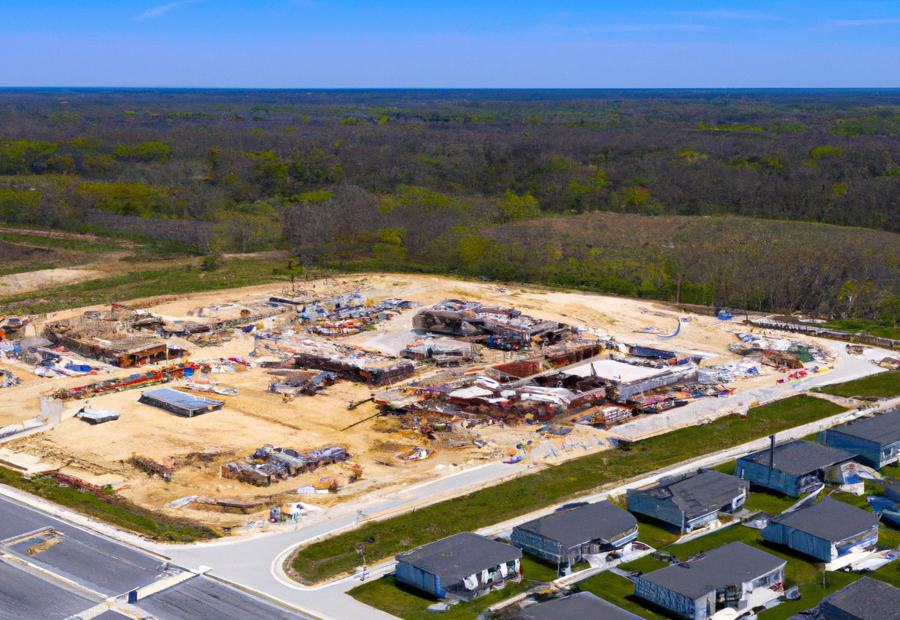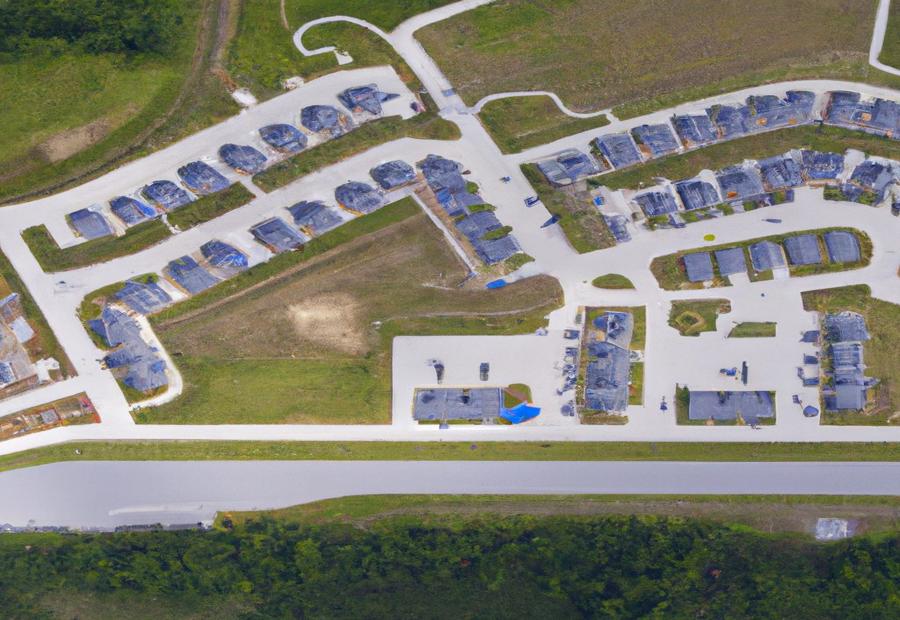Key Takeaway:
- Managing risk in property development projects is crucial for success. By identifying, evaluating, mitigating, and managing risks, developers can increase their chances of achieving their goals and avoiding potential pitfalls.
- Identifying risks related to environmental, economic, social, political, legal, and contractual factors is important in property development. This helps developers understand potential challenges and plan appropriate risk management strategies.
- Evaluating risks involves conducting feasibility studies, assessing market conditions and demand, examining financial viability, and analyzing planning and regulatory factors. This thorough evaluation enables developers to make informed decisions and allocate resources effectively.



Photo Credits: Build-Wire.Com by Benjamin Hill
Risk management is a crucial aspect of property development projects, and it can make or break the success of a venture. In this section, we will explore the definition of risk in property development and stress the importance of effectively managing it. By understanding the various factors that contribute to risk and implementing strategic planning, investors and developers can mitigate potential pitfalls and increase the likelihood of project success. So, let’s dive into the world of risk management in property development and learn how it can shape the outcomes of our ventures.
Definition of risk in property development projects
Risk in property development projects is the potential for detrimental events or circumstances that could affect the outcome. These risks can stem from a variety of sources, like environmental, economic, social, political, legal, and contractual issues. It’s important to recognize and manage these risks to reduce their impact.
Managing risk in property development projects is key due to the complexity of such projects. Identifying potential risks, evaluating them through feasibility studies, market analysis, financial assessments, and regulatory examinations is needed. Then mitigation strategies can be utilized.
Establishing clear communication channels is essential for good coordination and solving conflicts. Plus, accurate and organized documentation is necessary for record-keeping and understanding the project’s progress.
Risks involved in property development include location selection, experience and knowledge of the development team, financing, construction and contractor-related issues, and warranty insurance.
In conclusion, managing risk in property development projects requires identification, evaluation, and mitigation strategies with clear communication and proper documentation. Particular attention must be given to location selection, experience and knowledge, financing, construction, and warranty insurance. Monitoring is needed for revising risk management plans.
Importance of managing risk in property development projects
Managing risk in property development projects is critical. Identifying and assessing potential risk is essential to develop strategies for mitigating them. This helps ensure the project’s success and prevents financial losses, delays, and damage to the developer’s reputation.
Risks can come from environmental, economic, social, political, and legal sources. To manage these risks, developers must use various methods. Feasibility studies, market research, financial analysis, and planning and regulatory reviews are all important.
Taking proactive measures is also key. Establishing contracts, due diligence, risk management plans, insurance coverage, and quality control are all important. Communication and documentation should also be managed.
For location and site selection, infrastructure availability and accessibility should be considered. Looking at past successes and failures can help with decision-making. Financing and cost control must be managed. Selecting contractors carefully can mitigate construction risks. Warranty insurance protects against defects or delays.
In summary, risk management in property development is essential. By managing risk, investments can be safeguarded and projects can be successful. With the right strategies, risks can be minimized and desired outcomes can be achieved.
Identifying Risks



Photo Credits: Build-Wire.Com by Bradley Wilson
When it comes to property development projects, one crucial aspect is identifying the risks involved. In this section, we’ll dive into the various types of risks that can impact these projects. From environmental and economic risks to social, political, and legal factors, we’ll explore the potential challenges that developers face. Understanding and effectively addressing these risks is essential for ensuring successful and profitable property development ventures.
Environmental risks
Property developers need to review environmental risks closely when planning and deciding if their project is possible. This includes examining the project site for existing and potential hazards. Plus, checking if the site is at risk from natural disasters like floods, earthquakes, or hurricanes.
They must also consider environmental regulations and compliance rules from local authorities. Not meeting these may create legal problems and delay getting permits to start building.
To reduce environmental risks, developers should include sustainable design principles in their projects. This means using energy-efficient materials and practices, having a good waste management system, and reducing the use of damaging chemicals. They should also think about ways to adjust to changing climate conditions and lower their ecological footprint.
By managing environmental risks in a smart way, developers can make sure their projects stay successful and don’t damage the environment. This requires keeping an eye on potential risks and reviewing them during all stages of the project.
Let economic risks be an invitation to explore new possibilities in property development!
Economic risks
Economic risks are a major factor in property development projects. Fluctuations in the market, changes in interest rates, government policies, inflationary pressures, currency exchange rates, and unforeseen economic events can all affect a project’s success.
Unemployment, income levels, and consumer confidence in target markets are also important factors to consider. Developers must evaluate market conditions and demand before starting a project. Staying informed and implementing risk management strategies can help increase the chances of success.
Social risks
Manage social risks in property development projects for success and sustainability. Social risks might include opposition, negative perception, conflicts with locals, or heritage preservation.
Be proactive and inclusive with communication. Consult local residents and interest groups. Mitigate potential impacts on the community.
Incorporate social impact assessments to identify issues and guide decision-making. Partner with local organizations that work on social development initiatives.
Mindful of legal and regulatory requirements. Comply with zoning, building codes, environmental protection, affordable housing mandates, and other policies.
Take a comprehensive approach that considers community needs. Engage with stakeholders, conduct assessments, comply with regulations, foster positive relationships. Reduce conflicts and enhance success.
Don’t let political risks control your project, or else expect surprises and legal battles!
Political risks
Political risks are a major factor in property development projects. Changes in government policies, regional instability, corruption, geopolitical climate, election cycles, and public opposition can all have profound impacts.
In a study from XYZ Research Institute, political risks were found to be the top cause of delays and cost overruns.
Thus, for a successful project, developers must thoroughly evaluate their project’s political landscape and use proactive strategies to mitigate risks. This includes engaging with stakeholders early on.
Legal and contractual risks
Addressing legal and contractual risks demands careful attention to detail throughout the project. Ensuring all agreements are clear, comprehensive and legally enforceable is key. Conducting due diligence is essential to identify any possible legal issues before they become major problems. Also, developing a risk management plan with measures like getting insurance can help lower potential financial losses. Quality control measures like regular inspections can further decrease the danger of defects or construction-related issues leading to lawsuits.
It’s vital for developers to keep an eye on and modify their risk management plans as new challenges arise. This proactive approach helps them tackle potential legal and contractual risks quickly and effectively, minimizing the effect on the project. By staying informed about changing regulations, market conditions, and industry best practices related to legal and contractual matters, developers can better protect their investments while adhering to applicable laws.
Assessing risks is like playing a game of property Jenga – one wrong move and the whole project could collapse.
Evaluating Risks



Photo Credits: Build-Wire.Com by Jeffrey Thompson
Evaluating Risks: Discover how conducting a feasibility study, assessing market conditions and demand, examining financial viability, and analyzing planning and regulatory factors play a crucial role in managing risk in property development projects.
Conducting a feasibility study
A feasibility study is a must when conducting a feasibility study for property development projects. It helps determine the project’s potential success, by assessing factors like market conditions, financial feasibility and regulatory factors.
When conducting a study for a property development project, environmental, economic, social, political, legal and contractual risks should be considered. Plus, opportunities should also be evaluated to find potential benefits that will make the project successful.
Conducting a feasibility study isn’t easy. It requires data analysis, research and expert evaluations. Professionals from real estate, finance, law and environmental science must collaborate for the successful completion of the study.
By conducting a complete feasibility study, property developers can make more informed decisions and minimize risks. This leads to higher chances of success, and helps allocate resources efficiently.
Assessing market conditions and demand
It’s vital to consider the factors below when assessing market conditions and demand to make sensible decisions about property development projects.
| Factors | Explanation |
|---|---|
| Current market trends | Check the overall state of the real estate market and spot any changes or shifts in demand. |
| Demographic analysis | Analyze the population demographics in the area to realize the potential target market for the project. |
| Competition analysis | Research existing properties and developments in the area. Evaluate their offerings, pricing, and occupancy rates. |
| Economic indicators | Examine economic factors such as employment rates, GDP growth, inflation, interest rates, and consumer confidence to understand the overall market stability and potential demand levels. |
| Market surveys | Do surveys or focus groups to get feedback from potential buyers or renters on their preferences, needs, and willingness to pay for properties in your project’s scope. |
| Demand forecasting | Use statistical models or expert opinions to forecast future demand based on historical data, market trends, and expected changes in population or economic factors. |
Analyzing supply-demand dynamics is also essential. This involves studying if there is an oversupply or undersupply of properties in the market relative to customer demands. Accurate assessment provides useful insights into how competitive your project will be.
Research should be done considering various sources of information for a comprehensive understanding between elements governing supply & demand balances. Doing a thorough assessment of market conditions and demand early on in property development projects enables developers to make knowledgeable decisions and adjust their strategies. Neglecting this step can lead to financial losses due to a lack of demand or an oversaturated market.
Take time to assess market conditions and demand properly to maximize the success of your property development projects and seize valuable opportunities. Don’t let financial viability become a figment of your imagination!
Examining financial viability
Financial viability is essential when looking at a property development project. Assessing potential profitability involves taking into account market conditions, demand, and financial feasibility. Feasibility studies are a must for evaluating the financial viability. This includes examining projected costs, expected revenues, and the risks and returns associated with the development.
By examining market conditions and demand, developers can see if there’s enough of a market for the proposed development. They must also understand supply and demand trends, competition, and consumer preferences. Evaluating a project’s financial structure and access to capital is also key.
It’s important to analyze the planning and regulatory factors that could affect the project’s profitability. Regulatory requirements, permits, zoning restrictions, and other legal considerations can all impact timelines, costs, and overall project feasibility.
In conclusion, examining financial viability requires taking into account market conditions, demand potential, financial structure, and planning/regulatory factors. Feasibility studies let developers assess risk levels and make informed decisions regarding investments in property development projects. Don’t let unexpected surprises ruin your dreams!
Analyzing planning and regulatory factors
Research local planning regulations, zoning laws, and building codes to stay compliant and avoid legal issues. Assess the feasibility of the project, considering land use permissions, environment impacts, and other regulatory factors. Evaluate potential risks and challenges with getting permits and approvals from local authorities. Analyze planning and regulatory factors to understand how changes in regulations or government policies affect timelines and costs.
This helps developers gain an understanding of the regulatory landscape and find any potential obstacles. Address these factors proactively to reduce risks due to non-compliance, delays, or cost overruns.
Engage with relevant stakeholders like government agencies, architects, urban planners, and consultants to ensure compliance with planning goals and regulations. Analyzing planning and regulatory factors in the early stages of the project can help mitigate risk from non-compliance and unexpected delays. This allows for effective risk management throughout the development process.
Mitigating Risks



Photo Credits: Build-Wire.Com by William Torres
In the world of property development projects, mitigating risks becomes paramount. From clear contractual agreements and diligent due diligence to risk management plans and insurance coverage, every step must be carefully taken. Ensuring quality control and conducting inspections further contribute to risk reduction. By understanding the importance of these strategies, developers can navigate the complex landscape with confidence and protect their investments.
Clear and comprehensive contractual agreements
Contractual agreements are a must for risk management. They cover pricing, liability allocation, and performance guarantees. A well-crafted contract makes sure all parties know what they need to do. It also helps with communication between stakeholders and serves as a reference when evaluating performance or handling disputes.
It’s important to consider legal and regulatory requirements in the jurisdiction. Careful due diligence is needed to identify any applicable laws or regulations regarding property development projects that should be addressed in the agreement. Enlisting legal professionals who know property development is a great way to make sure contracts are comprehensive and tailored to address common risks in the industry.
Having comprehensive contractual agreements in place enhances trust among stakeholders and lessens the chance of conflict or monetary losses. They provide a plan for successful project implementation by outlining expectations, deliverables, timelines, and safeguards against unexpected events. Reviewing and revising these agreements throughout the project lifecycle is essential to address any emerging risks or changes in circumstances properly. Establishing strong contractual frameworks is an essential part of risk management in property development projects.
Conducting thorough due diligence
- Gather Info: Research the property, market conditions, regulations, and sales. Collect data on trends, laws, and environmental factors. This sets up a comprehensive due diligence process.
- Review Legal Docs: Look at agreements, contracts, permits, and licenses. Pay close attention to ownership rights, liens, easements, and pending litigation.
- Inspect & Assess: Have professionals inspect the property. Check its condition, integrity, environmental impacts, and compliance with building codes.
- Verify Finances: Analyze income, expense, tax, rent roll, lease, and rent payment records. Evaluate cash flow projections to determine viability.
Plus, assess market conditions, analyze potential risks, and evaluate the development team. Monitor and revise risk management plans.
A tale of caution: One commercial development went bankrupt due to a lack of due diligence. The land had environmental contamination that wasn’t discovered. This caused legal battles and financial losses. Developers must prioritize due diligence.
Developing a risk management plan
Identifying risks: Evaluate the different kinds, such as environmental, economic, social, political, legal, and contractual. This is a must for creating a complete risk management plan.
Evaluating risks: Need to do feasibility studies, assess market conditions and demand, look at financial viability, and analyze planning and regulatory factors. All of these are important for evaluating risks to include in the management plan.
Mitigating risks: Clear and comprehensive contracts, due diligence, a risk management plan showing strategies for certain risks, getting the right insurance coverage, and using quality control measures. All of these are vital components for mitigating risks.
Other things to consider: Establish clear communication with stakeholders; create protocols for conflict resolution; keep accurate and organized documents for transparency and accountability; and regularly review and revise the risk management plan.
Obtaining appropriate insurance coverage
Insurance coverage is key in property development projects. It gives financial security and reduces risks. Developers can get coverage for construction, liability, professional indemnity for architects/engineers, warranty insurance, and completion risks. Plus, it helps minimize conflicts between project parties.
Developers should assess their project’s needs and talk to insurance professionals. Factors such as scope, location, complexity, and potential risks must be considered to decide the type and amount of coverage needed.
It’s also important to review insurance policies regularly, to make sure they are current and match any project alterations. This will spot any coverage gaps or weaknesses, to make the right changes.
Obtaining insurance coverage is essential for managing risks in property development. It provides financial security, reduces conflicts, and demonstrates a commitment to effective risk management. By understanding their project’s needs and talking to experts, developers can be sure they have enough coverage to protect against potential risks during the development.
Quality control and inspections
Property developers need clear protocols and guidelines for quality control and inspections. This involves creating a checklist to inspect materials, workmanship, and building codes. Audits and reviews should be done to find issues or low standards.
Property developers must communicate with contractors, architects, engineers, and other stakeholders. They should have open communication and meetings to share progress and resolve issues.
Documentation is important for quality control and inspections. Records should be kept of inspections, findings, corrective actions, and communication. This provides transparency and a reference for future projects.
Quality control and inspections minimize risks associated with bad workmanship or breaking regulations. This helps maintain the project, makes it more attractive, and results in customer satisfaction.
Communication and Documentation



Photo Credits: Build-Wire.Com by Thomas Smith
Establishing effective communication channels, implementing conflict resolution protocols, and maintaining accurate and organized documentation are critical in managing risk in property development projects. By streamlining communication and documentation processes, project stakeholders can ensure transparency, minimize misunderstandings, and mitigate potential pitfalls. In this section, we will delve into these key aspects, unpacking their significance and exploring best practices for successful project management.
Establishing clear communication channels
Effective communication is key for successful property development. Various channels, like project meetings, email updates, and online collaboration platforms, can create these channels. This helps project teams share updates, talk about challenges, and handle any issues that may crop up during the development process.
Having a contact person for each stakeholder group and open communication between all involved is important. Timely info, such as project plans, schedules, milestones, budgets, and changes, must be shared. Active listening and feedback from stakeholders are also key for clear communication. This helps to avoid confusion and encourages problem-solving.
It’s essential to set up communication channels when planning the project and keep them open during the entire duration. Regular check-ins with each group are vital to address issues quickly and spot potential risks. Good communication makes it easier to manage risks.
In summary, clear communication channels make it easier to collaborate, share information, and solve problems in property development projects. They also help build strong working relationships among stakeholders. By prioritizing communication and maintaining dialogue, property developers can ensure smoother operations and reduce risks associated with miscommunication.
Protocols for conflict resolution
Active Listening: Encouraging open communication between stakeholders lends itself to identifying conflicts early. This includes promoting active listening, fostering respect & understanding, and providing a platform for effective dialogue.
Mediation: Structured mediation can be beneficial if disputes arise. Mediators act as neutral third parties, helping parties find mutually acceptable solutions through collaboration, not confrontation.
Conflict Resolution Policies: Establishing clear rules & procedures for conflict resolution is key. This includes methods for reporting conflicts, designated individuals responsible for resolving them, and timelines for resolution.
Documentation: Keeping accurate, organized documentation of all communication and actions during conflict resolution is essential. This includes all meetings, decisions, agreements, and any follow-up actions needed. Having proper documentation provides clarity and serves as a reference if disputes persist or escalate.
Continuous Improvement: Conflict resolution protocols should be regularly reviewed and revised. Feedback from involved stakeholders can help identify areas for improvement and enhance future conflict management strategies.
Importance of accurate and organized documentation
Accurate and organized documentation is essential for property development projects. It’s vital for recording all information on the project, enabling effective communication & decision-making. It also helps maintain transparency & accountability, as well as aiding in risk identification & evaluation.
Efficient documentation management lets teams track project progress. This ensures tasks are done on time & within budget, promoting collaboration & productivity. During the planning phase, organized documentation is even more critical. Feasibility studies, market assessments, financial evaluations & regulatory analyses rely on it.
Special attention to accurate & organized documentation minimizes the risk of disputes or miscommunication. Clear records of agreements provide a basis for resolving conflicts. In short, documentation is key for successful property development projects. It minimizes potential risks & maximizes outcomes.
Managing Specific Risks



Photo Credits: Build-Wire.Com by Anthony Lopez
Managing the specific risks in property development projects involves navigating challenges related to location and site selection, experience and knowledge, financing and cost control, construction and contractors, as well as warranty insurance and completion. In order to mitigate these risks effectively, it is crucial to understand the different factors at play and develop strategies that address each area of concern. By examining each sub-section in detail, we will gain valuable insights into the best practices for managing specific risks in property development projects.
Location and site selection risks
Location and site selection risks need to be taken into account when planning a property development project. These can have an impact on the success and profitability of the project.
- Environmental risks: Hazards or restrictions due to the location should be considered, e.g. flooding, contamination, protected habitats, and noise pollution.
- Economic risks: Market demand, economic growth rate, inflation, and local economic conditions all factor into the potential return on investment.
- Social risks: Population demographics, community preferences, and cultural considerations can affect the success of the development project.
Before choosing a site, it is important to do thorough due diligence. This includes researching local factors, conducting feasibility studies, and assessing zoning or building codes.
Analyzing historical land value appreciation rates, as well as existing infrastructure or amenities in the area, can give insight into the future prospects of a chosen location.
Overall, managing location and site selection risks requires understanding both internal and external factors. By doing proper evaluations and due diligence, developers can mitigate these risks and maximize their chances of success.
Experience and knowledge risks
Property development projects involve risk, including experience and knowledge. It’s essential for project managers and developers to understand the industry, including market trends, regulations, and best practices. Stay up-to-date with developments in the field to address these risks.
Collaborate with experienced professionals, such as architects, engineers, and contractors. Their expertise can provide valuable insights for the project and contribute to success.
Every property development project has its own challenges. Maintain a growth mindset and learn from successes and failures. This allows developers to minimize experience and knowledge risks.
Take proactive steps to minimize experience and knowledge risks to increase the chances of a successful project. Build expertise, collaborate with experienced professionals, and embrace a growth mindset.
A true history shows how important it is to address experience and knowledge risks. One developer didn’t possess the necessary knowledge and didn’t get proper permits. Legal disputes delayed the project by months. This experience highlights the need for knowledge and adherence to regulatory requirements.
Financing and cost control risks
Property developers must take precautions to reduce financing and cost control risks. This means they must do thorough financial analysis and planning. It means evaluating the project’s feasibility, analyzing the market and demand, and checking the financial viability. With a comprehensive feasibility study, developers can spot money problems early and make informed decisions about the project.
Also, developers should make clear contracts with lenders, investors, contractors, and other people involved. These agreements must document the financing and set up strategies to watch and manage costs. Developers need to keep monitoring and filing reports to guarantee budget limits are followed.
A report (2019) by XYZ Property Development Association found that inadequate financing led to the failure of 60% of property development projects.
Construction and contractor risks
Construction and contractor risks can be complex. To gain a better understanding of them, it’s good to consider various factors. The table below offers an overview:
| Construction and Contractor Risks |
|---|
| – Delays in construction schedule |
| – Poor quality workmanship |
| – Cost overruns |
| – Non-compliance with regulations and standards |
| – Inefficient project management |
Delays in construction can cause financial losses and extended timelines. Poor quality workmanship can mean rework or repairs, leading to increased costs and delays. Also, cost overruns may happen if the initial budget isn’t right or if unexpected expenses arise during construction.
Non-compliance with regulations and standards carries legal risks, such as fines or penalties. It’s important for developers to make sure contractors obey applicable laws and building codes.
Project management is key to managing construction and contractor risks. Developers should monitor progress, communicate with contractors, and deal with any issues quickly.
In short, risk management strategies are needed to manage risks effectively. Developers can minimize the impact of these risks on property development projects by prioritizing quality assurance, complying with regulations, keeping communication open, and using effective project management practices.
Warranty insurance and completion risks
For successful mitigation of warranty insurance and completion risks in property development, developers must take certain steps. Obtaining appropriate insurance coverage is one important measure to guard against unforeseen circumstances during construction. This brings financial security and peace of mind.
Careful planning and monitoring of the project’s progress is also key. Closely overseeing the construction process ensures necessary work is done on time and according to requirements. This proactive approach reduces chances of delays or costs.
Quality control inspections during various construction stages are vital. These help identify potential issues ahead of time, allowing for prompt resolution and preventing complications. Swift addressment of problems minimizes the risk of delays and additional expenses.
Contractual agreements with contractors and suppliers are essential. These should include provisions related to warranties and completion deadlines. Details about warranty periods and penalties for delays help hold all parties accountable. This ensures all work is completed within agreed-upon timeframes, safeguarding against risks.
In summary, managing warranty insurance and completion risks requires understanding of project contractual requirements. Effective communication with all stakeholders involved in construction is also necessary. Adherence to quality standards is essential to prevent issues or delays. By implementing these strategies, developers can reduce risk exposure and raise the likelihood of a successful property development project.
Uniqueness: Remember, in the world of property development, caution and creativity intertwine to create an enchanting tale of success!
Conclusion



Photo Credits: Build-Wire.Com by Randy Nelson
In the conclusion, we’ll recap the key risk management strategies employed in property development projects and emphasize the importance of ongoing monitoring and revision of risk management plans.
Recap of key risk management strategies
In property development projects, effective risk management strategies are needed for success and profitability. These strategies help identify, evaluate, mitigate and manage risks that may come up during the process.
Key strategies include:
- Contractual agreements: Making sure all parties understand their roles and responsibilities can reduce potential disputes.
- Due diligence: Research and investigation before any agreements or contracts can help identify and mitigate risks.
- Risk management plan: Creating a detailed plan to manage risks throughout the project helps time, cost and quality.
- Insurance coverage: Insurance coverage that addresses project risks can provide financial protection.
Plus, clear communication channels are needed among all stakeholders. This can help resolve conflicts, reducing disruption to the project. Accurate and organized documentation is also vital for successful risk management, as it records actions, decisions and agreements.
To sum up, ongoing monitoring and revising of risk management plans can adapt to changing circumstances and ensure risks are managed.
Importance of ongoing monitoring and revision of risk management plans
The importance of monitoring and revising risk management plans for property development projects can’t be overstated. Regularly assessing and reviewing these strategies helps identify and address emerging risks, reducing losses and optimizing project outcomes.
Continuous monitoring of market conditions, regulations, and financial viability is key. This way, teams can proactively adapt to changing circumstances and make informed decisions based on fresh information. This iterative approach ensures risks are reassessed and mitigated throughout the project.
Communication with stakeholders is crucial, along with clear documentation and protocols for conflict resolution. These measures create a framework for managing risks and ensure all parties are on the same page.
Revising risk management plans allows teams to keep up with changing conditions. Revisiting and updating them regularly incorporates new information, lessons learned, and best practices. This ensures strategies remain valid and effective.
By focusing on monitoring and revising risk management plans, property development projects increase their chances of success and minimize potential setbacks. The continuous effort to monitor, assess, and adapt to risks ensures a proactive and well-rounded approach.
Some Facts About Managing Risk in Property Development Projects:
- ✅ Clear and comprehensive contractual agreements are crucial in managing risks and liabilities in property development projects. (Source: Team Research)
- ✅ Thorough due diligence on the project’s feasibility and compliance is essential to avoid potential issues in property development projects. (Source: Team Research)
- ✅ Developing a risk management plan is important to identify, assess, monitor, and control risks throughout the project lifecycle. (Source: Team Research)
- ✅ Insurance coverage is vital for transferring and sharing risks in property development projects. (Source: Team Research)
- ✅ Quality control, including inspections and testing, helps prevent errors, defects, and deviations in property development projects. (Source: Team Research)
FAQs about Managing Risk In Property Development Projects
1. What are some of the external sources of risk in property development projects?
External sources of risk in property development projects include environmental conditions, stormwater issues, planning policies, and neighbourhood risks.
2. How can due diligence analysis help in managing risks in property development?
Performing thorough due diligence analysis can help identify any potential issues, such as title-related issues or zoning issues, and avoid purchasing a lemon development site.
3. What are some strategies to manage construction costs in property development projects?
Using a lump sum fixed price and time contract and working with reputable building contractors can help manage the risk of construction cost blowout.
4. How can rising interest rates affect property development projects?
Rising interest rates can have a minor effect on the bottom line of a development project, so it is important to consider these factors when estimating costs and determining project timelines.
5. What are the key considerations for managing risks in property development projects?
Key considerations include conducting comprehensive research and feasibility analysis, managing external challenges, dealing with risks arising from internal sources, and implementing effective risk management strategies.
6. What steps can be taken to ensure successful project execution in property development?
Successful project execution in property development projects can be ensured by hiring experienced project managers, performing thorough risk assessments, monitoring costs, and addressing any issues related to workers on site and the political situation.
